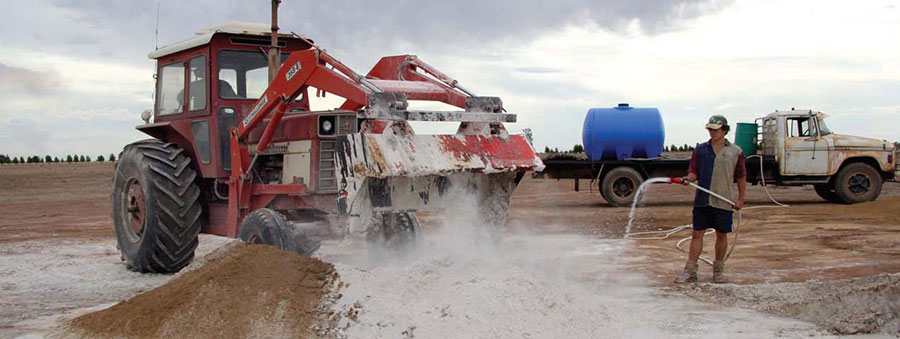
Case
Study
Location
Riverina, New South Wales
Crop
Grain
Hamblin Family, Matong NSW
Riverina grain grower, Wayne Hamblin, is earning handy premiums by meeting the growing demand of high energy, chemical-free grain from organic dairy farmers.
Together with wife, Kim, and son, Chad, Wayne conducts a mixed cropping and livestock operation on ‘Big Tree’, Matong, about 70km north-west of Wagga Wagga. The 1,600 ha property has been in family hands for more than 100 years.
The Hamblins grow about 640ha of wheat, oats, barley, vetch and clover under a three to five year cropping program followed by a three-year pasture phase.
‘Big Tree’ is also home to 1,800 first-cross Dorper ewes, which are joined to Dorper rams for prime lamb production, and 30 Santa Gertrudis cross and Brangus cows, which are joined to Angus bulls to produce vealers.
“As part of their push to resuscitate their ailing property, they replaced conventional fertiliser with ‘biologically active’ solid nutrients and fermented liquid cultures from BioAg.”
Wayne became concerned that he was mining the soil and leaving little for future generations. “The ground had become hard and we seemed to be pouring more and more chemicals onto the soil for less and less results,” Wayne said.
“We were adding more fertilisers, having bigger weed problems, our worms had disappeared and our yields weren’t getting any better. A lot of our grain was shrivelled, the quality wasn’t as good as it used to be and the animal health didn’t seem to be as good either. I was taught to farm by chemical and fertiliser representatives, and in the end, I had become an expert on applying chemicals. I didn’t think that was the way to farm if we were going to have anything left for the next generation.”
As part of their push to resuscitate their ailing property, they replaced conventional fertiliser with ‘biologically active’ solid nutrients and fermented liquid cultures from BioAg.
BioAg’s formulations not only provide a rich source of plant-available nutrients but also introduce beneficial microbes into the soil to produce a living, healthy and balanced soil for optimum plant and livestock productivity.

Mixing BioAgPhos and lime on ‘Big Tree’, Matong.
One of the company’s key products is BioAgPhos®, a reactive phosphate rock that has been treated with a proprietary microbial culture to provide an immediate and continuing source of plant-available phosphate.
About half of the 15 percent phosphorus content is available immediately for plant use, while the remainder is slowly digested by the micro-organisms and added to the nutrient reservoir in the soil.
The improved soil microbial activity is also claimed to help unlock phosphorus, calcium and sulphur already in the soil, leading to longterm benefits in soil structure and fertility.
The Hamblins apply 120kg per ha of BioAgPhos and 300kg per ha of lime using a belt-spreader in autumn. BioAgPhos, is a reactive phosphate rock that has been treated with a proprietary microbial culture to provide an immediate and continuing source of plant available phosphate.
The liquid treatment, BioAg Soil & Seed™, is sprayed directly into the soil ahead of the air seeder at sowing.
The Hamblins also apply BioAg Digest-it®, a stubble treatment that accelerates decomposition of crop residues and improves soil microbial activity. “We mix it with a bit of urea to kick the nitrogen cycle off, then we disc the stubble back in with an offset disc, harrow it and sow directly into it,” Wayne said.
Wayne said there had been a noticeable improvement in the quality of the light red loams to heavy dark clay soils on ‘Big Tree’ over the past five years. “The soil is more friable and the hard pan is starting to disappear,” he said.
“Worms are returning and the amount of organic matter, which barely registered before, has increased to three percent. It smells like a vegetable garden.
My father was very sceptical about biological farming at first but now he’s seen what’s happening and he’s turned around. He says things are returning back to what they were when he was a kid.”
At the same time, the Hamblins have slashed their chemical usage, while insect and fungal disease problems – including Take-all and Rhizoctonia – have all but disappeared.
“We haven’t used a fungicide on our seed for five years,” Wayne said. “It takes two or three years before you get to the stage where you can grow wheat on wheat and be fairly confident you won’t get any diseases.
“There are fewer inputs and at the end of the day you’ve got a reasonably good, healthy soil, so it’s more viable. I guess it boils down to how much you care for your land”
Last year, they sold 100 tonnes of wheat to an organic dairy farmer in the Upper Murray Valley, who happily paid $200 a tonne for the grain because of its high protein and low screening – about $50 per tonne premium above the usual asking price for feed wheat.
They also sold 400 tonnes of barley at $180 a tonne to another dairy farmer who is in the process of converting to organic production.
The grain was stored on-farm in airtight plastic tubing, thereby avoiding the need to apply a grain fumigant.
Already staunch supporters of biological farming, the Hamblins are now investigating the feasibility of becoming accredited organic farmers. “Once you start to farm this way you’d never go back to conventional methods,” Wayne said.
“There are fewer inputs and at the end of the day you’ve got a reasonably good, healthy soil, so it’s more viable. I guess it boils down to how much you care for your land.”
The BioAg approach has already been adopted by hundreds of Australian farmers and is being trialled by independent agricultural organisations.
BioAg products are ideal for use in both conventional and organic production systems.
Download case study
Download a PDF version of the above case study.

Recent Comments